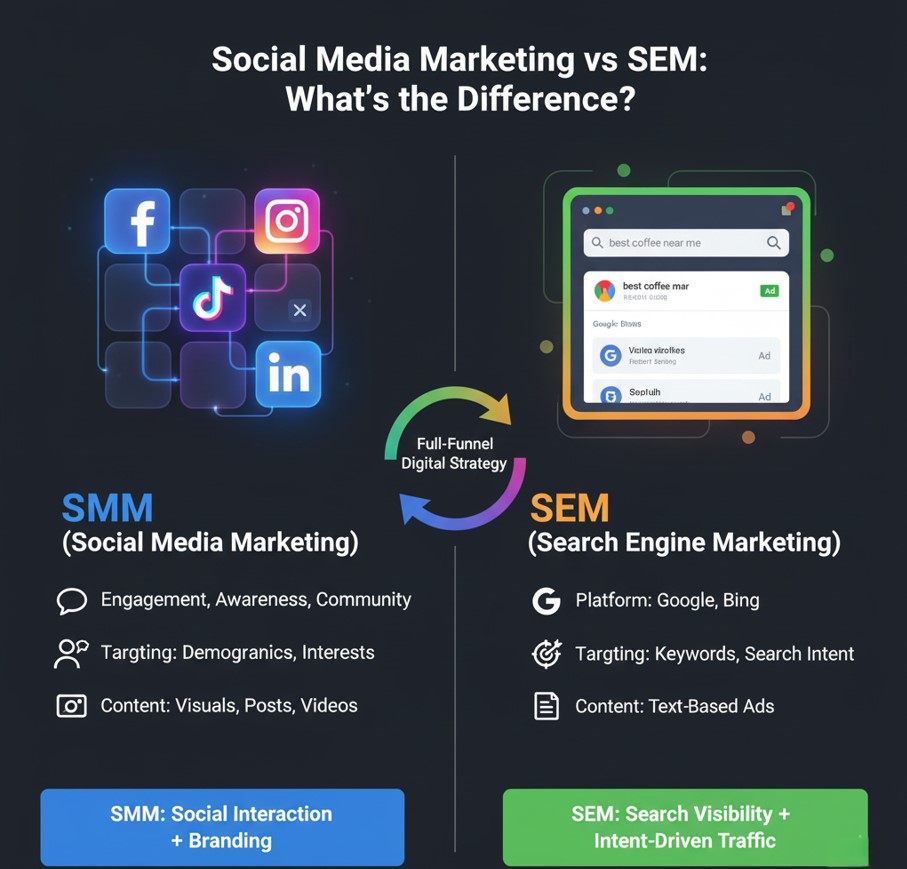
In today’s hyper-connected digital world, social media is more than a place to post selfies or share vacation photos—it’s a powerful business tool. Whether you run a startup, a brick-and-mortar shop, or an enterprise-level company, chances are your customers are on social media.
This is where Social Media Marketing (SMM) comes into play.
In this comprehensive guide, we’ll cover:
- What is social media marketing?
- Why it’s essential for businesses
- The difference between SMM and SEM
- Popular platforms for marketing
- How social media marketing for small businesses works
- Strategy, content, tools, and more
Let’s dive in.
What Is Social Media Marketing?
Social media marketing is the process of creating and sharing content on social media platforms to achieve marketing and branding goals. It involves activities like:
- Publishing posts
- Running paid ads
- Engaging with followers
- Collaborating with influencers
- Analyzing data
The goal is to build awareness, drive engagement, generate leads, and boost conversions through platforms like Facebook, Instagram, X (formerly Twitter), LinkedIn, TikTok, YouTube, and Pinterest.
In essence, it’s about using social platforms strategically to connect with your audience.
Why Is Social Media Marketing Important?
Social media has become a critical channel for modern businesses. Here’s why:
1. Your Customers Are Already There
With over 4.8 billion active users worldwide, social media platforms are where your audience spends time daily. If you’re not present, you’re missing out on opportunities to connect and convert.
2. Cost-Effective Marketing
Compared to traditional advertising, SMM is affordable, especially for startups and small businesses. Even with a limited budget, you can reach thousands—or even millions—through organic content and low-cost paid ads.
3. Builds Brand Awareness and Trust
Social media allows for authentic, two-way conversations with your audience. This interaction builds trust, loyalty, and long-term brand equity.
4. Generates Leads and Sales
Platforms like Facebook, Instagram, and LinkedIn provide tools to generate leads directly through call-to-action buttons, lead forms, and shoppable posts.
5. Measurable ROI
Most social platforms offer built-in analytics. You can measure clicks, conversions, impressions, reach, engagement rates, and more, helping you refine your strategy for better ROI.
Social Media Marketing vs SEM: What’s the Difference?

Many people confuse SMM with SEM (Search Engine Marketing), but they are not the same.
| Feature | SMM (Social Media Marketing) | SEM (Search Engine Marketing) |
|---|---|---|
| Platform | Social media networks like Facebook, Instagram, etc. | Search engines like Google, Bing |
| Focus | Engagement, awareness, community | Targeted visibility in search results |
| Targeting | Demographics, interests, behaviors | Keywords and search intent |
| Content | Visuals, posts, videos, stories | Text-based ads, landing pages |
| Cost | Organic + paid options | Mostly paid (PPC) |
In short:
SMM focuses on social interaction and branding
SEM is about search visibility and intent-driven traffic
They’re often used together in a full-funnel digital marketing strategy.
Core Components of a Social Media Marketing Strategy
To succeed with social media, you need more than just random posts. Here’s a breakdown of what makes up a solid SMM strategy:
1. Set SMART Goals
Define specific, measurable goals, such as:
- Increase followers by 20% in 3 months
- Generate 50 leads via Facebook each month
- Drive 10,000 monthly visits from Instagram
2. Know Your Audience
Create audience personas based on:
- Demographics (age, gender, location)
- Interests (hobbies, behaviors)
- Challenges and pain points
Knowing your audience ensures your content is relevant and engaging.
3. Choose the Right Platforms
Not all platforms are equal for every business. Here’s a quick overview:
| Platform | Best For |
|---|---|
| Broad B2C and B2B audiences, local businesses | |
| Visual storytelling, fashion, lifestyle, beauty | |
| B2B marketing professionals, SaaS | |
| X (Twitter) | Real-time news, updates, tech, startups |
| TikTok | Short-form videos, Gen Z, creative brands |
| YouTube | Video tutorials, product demos, reviews |
| DIY, eCommerce, home decor, planning |
4. Content Strategy
Mix up your content types:
- Educational content (how-to, tips)
- Promotional content (offers, products)
- User-generated content
- Behind-the-scenes posts
- Live sessions and Q&A
Follow the 80/20 rule: 80% value-driven content, 20% promotional.
5. Use Hashtags & Keywords
Hashtags increase visibility. Combine branded hashtags (#YourBrandName) with trending or niche-specific ones.
Also, optimize your profile and posts with keywords for platform-specific SEO (especially on LinkedIn and YouTube).
6. Engage Consistently
Engagement is a two-way street. Respond to comments, DMs, and mentions. Show appreciation for user-generated content. Use polls, questions, and interactive stories to spark conversation.
7. Leverage Paid Ads
Almost all platforms offer powerful advertising options with detailed targeting.
For example:
- Facebook Ads for lead generation
- Instagram Shopping for eCommerce
- LinkedIn Ads for B2B service companies
Even with small budgets, paid social can drastically boost reach and results.
Social Media Marketing for Small Businesses
If you’re a small business owner, social media can be your most powerful weapon.
Why it works:
- Low budget, high return: You don’t need a large ad budget to make an impact.
- Local targeting: Platforms like Facebook let you geo-target users by zip code or neighborhood.
- Community building: You can build a local following and loyal customer base.
- Word of mouth & referrals: Happy customers tagging you or sharing your posts is free marketing.
Simple steps to start:
- Pick 1–2 platforms where your customers hang out.
- Set up professional profiles with bios, photos, contact info.
- Post 3–5 times per week with a mix of value and promos.
- Use local hashtags, tag other local businesses.
- Respond quickly to comments and messages.
- Ask for reviews and share testimonials.
- Run small ads for promotions, events, or lead capture.
Pro tip: Many small businesses see success with a combo of Facebook + Instagram + Google My Business. Keep it manageable!
Tools to Improve Your Social Media Marketing
You don’t have to do everything manually. These tools can streamline your workflow:
Scheduling & Automation
- Buffer
- Hootsuite
- Later
- Meta Business Suite
Graphic Design
- Canva
- Adobe Express
- Crello
Analytics & Reporting
- Sprout Social
- SocialPilot
- Google Analytics (track social traffic)
Influencer Discovery
- BuzzSumo
- Upfluence
- Heepsy
Social Media Marketing Trends in 2025
Stay ahead of the game by watching for these emerging trends:
- Short-form video still dominates — TikTok, Instagram Reels, YouTube Shorts.
- AI-generated content and scheduling — faster workflows, smart recommendations.
- Social commerce — seamless shopping inside Instagram and TikTok.
- Micro-influencers > celebrities — authentic voices are trusted more.
- Community-driven marketing — private groups, live chats, and closed communities are growing.
- Augmented reality (AR) — try-before-you-buy filters, virtual product testing.
- Ethical branding & social values — customers prefer brands that take a stand.
Common Mistakes to Avoid
Even with the best tools and intentions, many businesses stumble. Avoid these:
- Posting without a plan
- Ignoring customer comments and messages
- Using the same content on all platforms
- Being too salesy in every post
- Buying followers or engagement
- Failing to track results or ROI
Consistency + authenticity = long-term success.
Real-World Example: Social Media Marketing in Action
Business: A small, family-owned bakery in Chicago
Goals: Boost local orders and online delivery
Platforms: Facebook & Instagram
Strategy:
- Posted daily behind-the-scenes baking videos
- Ran a weekly “Flavor Poll” to let users vote on new cupcake flavors
- Used Facebook Ads with local targeting (10-mile radius)
- Partnered with local micro-influencers for shoutouts
- Shared customer reviews and birthday celebration stories
Results after 6 months:
- 8,000+ followers on Instagram
- 3X increase in online orders
- Local press coverage picked up via viral birthday post
- 22% of traffic came from Facebook referrals
This shows how effective social media marketing for small businesses can be—even with a low budget.
Final Thoughts
Social media marketing isn’t just a trend—it’s a core part of modern marketing strategy.
Whether you’re a solopreneur, local business owner, or scaling startup, social media gives you the tools to:
- Grow your brand
- Engage with customers
- Drive leads and sales
- Build trust and community
It’s never too late to start. Focus on platforms where your audience lives. Share value consistently. Use smart tools. Measure everything. And most importantly—be human.
FAQs About Social Media Marketing
Q: How often should I post on social media?
A: Aim for 3–5 times per week per platform. Quality and consistency matter more than quantity.
Q: Is social media marketing free?
A: Organic posting is free, but reaching a larger audience often requires a budget for paid ads.
Q: Which platform is best for my business?
A: Depends on your audience. Facebook and Instagram are good starting points for most B2C businesses; LinkedIn for B2B; TikTok and Pinterest for niche visual content.
Q: How is social media marketing different from SEM?
A: SEM targets people actively searching for products (via Google), while social media marketing engages people where they socialize online. They complement each other.
Learn more about: Facebook Ads Strategies for Local Service Providers


Leave a Reply